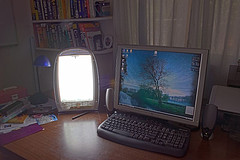Abstract:
A novel approach to restoring sight using a ‘bionic eye‘ is being investigated at Swinburne University of Technology.
The laser stimulation of optic nerves is the focus of this research to develop a vision prosthesis – perhaps a tiny laser device fitted in a pair of spectacles – much like the cochlear implant for restoring hearing.
Bionic eye hope blends lasers and gold
Swinburne’s Applied Optics and Biomedical Engineering Groups are seeking government and philanthropic funding to progress this research using gold nanoparticles to amplify laser light.
Laser physicists have, for the first time, succeeded in real-time observation of laser-accelerated fast electron swarms in conjunction with a plasma wave consisting of positively charged helium ions and slow background electrons. The findings will help development of new X-ray sources with much higher resolution than current devices allow for biomedical applications, as well as facilitate development of new electron and light sources for exploring the structure of atoms and molecules.
This is a preview of LASER: New source for X-rays providing Higher resolution.
Read the full post (678 words, 3 images, estimated 2:43 mins reading time)
21. Define subjective brightness and brightness adaptation?
Subjective brightness means intensity as preserved by the human visual system.
Brightness adaptation means the human visual system can operate only from
scotopic to glare limit. It cannot operate over the range simultaneously. It accomplishes
this large variation by changes in its overall intensity.
22. Define weber ratio
The ratio of increment of illumination to background of illumination is called as
weber ratio.(ie) ?i/i
If the ratio (?i/i) is small, then small percentage of change in intensity is needed
(ie) good brightness adaptation.
If the ratio (?i/i) is large , then large percentage of change in intensity is needed
(ie) poor brightness adaptation.
This is a preview of INTERVIEW AND SHORT ANSWER QUESTION ON IMAGE PROCESSING-BIOMEDICAL JOBS & NOTES QUESTION 21-40.
Read the full post (783 words, 1 image, estimated 3:08 mins reading time)
Phototherapy
Definition
Phototherapy, or light therapy, is the administration of doses of bright light in order to normalize the body‘s internal clock and/or relieve depression.
DESCRIPTION
Phototherapy is generally administered at home. The most commonly used phototherapy equipment is a portable lighting device known as a light box. The box may be mounted upright to a wall, or slanted downwards towards a table. The patient sits in front of the box for a prescribed period of time (anywhere from 15 minutes to several hours).

